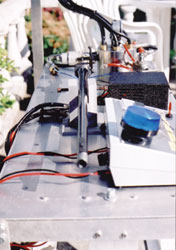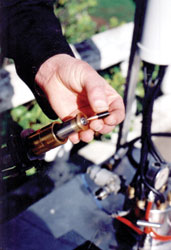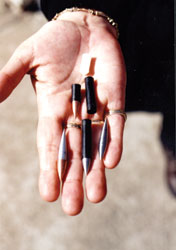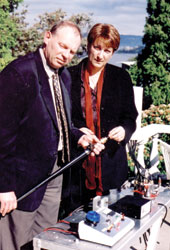It’s a gas
by Reg A Watson



 A new gun technology has been developed by
a Tasmanian couple, Roger and Maria Webb. In short, the Webb’s innovation
is a gun that uses no gunpowder; it is almost silent and has no muzzle
flash. When the gun is fired it is practically impossible to tell where the shot came from.
A new gun technology has been developed by
a Tasmanian couple, Roger and Maria Webb. In short, the Webb’s innovation
is a gun that uses no gunpowder; it is almost silent and has no muzzle
flash. When the gun is fired it is practically impossible to tell where the shot came from.
The gun’s capability has been demonstrated in front of army, navy and police personnel - all of which were suitably impressed.
The Webbs have worked on the technology with their partner, Project Director Mike Turner of SVP Industries of George Town, Tasmania. There has been more than 10,000 hours of research and development into the concept and other civilian-use capabilities. After satisfactory development, the army was approached. Their response was, “if it works, we will be interested”.
The potential of this new technology is enormous. Interest has been expressed from the USA, the UK and even from Bangladesh, Taiwan, Canada, Israel and Japan.
“Everyone is looking for something that is safer, but with technological superiority over what is conventionally used,” according to Roger. “There are no spent cartridge cases, no lead nor environmental degradation. For years the armed forces of many countries have been interested in any new such technology.
“Originally we trialled and test fired the prototype gun at the Buckland firing range, then we used the Pontville range for our major demonstration.
“We were restricted using 3000PSI because of the range template and we were working under military OHS prescriptions. At Buckland we were calculating the elevation of the barrel at a target of 100 metres using 2500PSI. Firing it, we aimed about 75mm above the target and 150mm to the side, as we had a 15-knot gust coming from the right. The shot went straight over the target and we heard it hit the trees well behind the target, another 200 metres. We had reached well over 300 metres.”
At Pontville, not only were Army and Special Operations personnel present, there were three representatives from the Tasmanian Police Ballistic, as well as representatives from the State Development Department, the Industrial Supplies Office and a Royal Australian Navy Lieutenant Commander. The demonstrations fired eight metal projectiles and a plastic ‘crowd control’ or ‘riot’ projectile from the HVL-Co technology demonstration weapon. The same principle can be used for all barrel guns - handguns, rifles, machine guns, mortars, artillery, tanks and weapons in aircraft and ships.
A major factor is that these guns will be manufactured from composite plastics. They will be more than 70 per cent lighter than present guns offering greater maneuverability and better tactical capabilities at a much lower cost.
Generally, at the point of leaving a barrel, conventional bullets only use about 36 per cent of the exploded gunpowder potential energy; on the average HVL-Co discharge, the projectile has more than 80 per cent of the energy force efficiency due to less barrel friction and this new technology.
The gun demonstrated by the Webbs used a 7.26 standard rifle barrel, which they modified to suit their technological needs. The breech was manufactured to suit the new projectile design, which meant a special loading method as well as complete compliance with all safety procedures.
The carrier of the projectile is Teflon impregnated with carbon and eventually the barrels will consist of a composite of hardened stainless steel, aluminium and Kevlar. The Webb’s design of the projectile is an aerofoil because it is more stable as it goes through the air with minium turbulence while maintaining optimal rotational motion. It has a positive and negative lift as the air flows over it. Its counteracting ability as it flows through the air is similar to an aircraft wing. It is of a peculiar shape and it vastly reduces the turbulence at the rear of the projectile as it goes through the air by about 90 per cent. The benefit is a higher velocity and provides further distant reach in a more straight-line path. It reduces all the inefficiencies of other currently used projectiles.
The front of the nose shape is accurately designed and narrows the angles of the shock waves at the front, which come off at a 45-degree angle. The shape sweeps the air over it.
“The noise factor is about as loud as opening a can of Coke,” said Roger. The Webbs add that there will be a variation of projectiles, such as a copper head with an aluminium tail or all aluminium. An armour piercing capability is under design as well.
The potential of the invention is obvious. The Webbs, however, desperately want to keep it in Australia. It is up to the Australian authorities to see to that.
